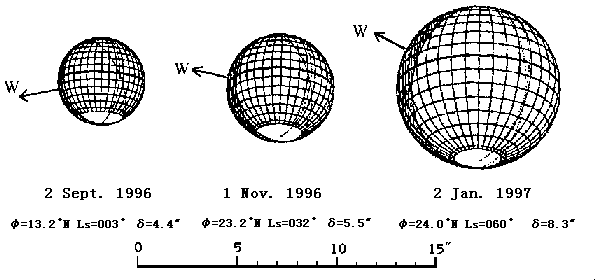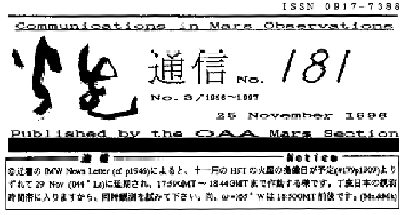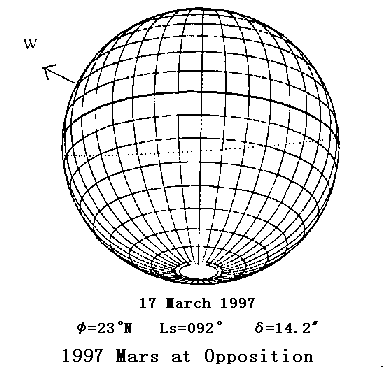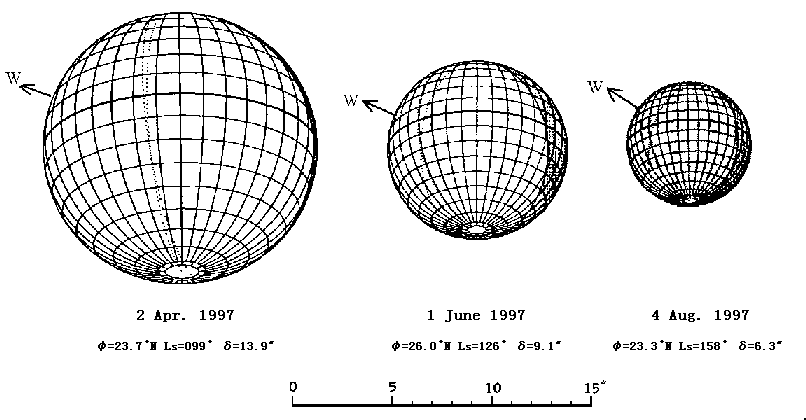
 CMO #181
CMO #181
- From #181 we cite 4 articles -
.. Index ........
* OAA MARS SECTION
-- Mars Observation Reports of 1996/97 (#003)--
* Coming 1996/97 Mars (2)
-- Disks Displying the Relative Size and Phase in 1996/97
* Coming 1996/97 Mars (3)
-- Ephemeris 1996 Dec.- 1997 Mar.
* 10 Years Ago (11)
-- CMO #020(10 November 1986) and #021(25 November 1986) - (Japanese)
◆1996/97年の火星 -- ( 2 )--
(Japanese)
1996/97年の火星の見かけの大きさや位相の変化-- 南政次(文) 西田昭徳(図)

* This is an article which shows how the planet Mars will approach the Earth and go away in the upcoming apparition. We here try to represent the status of the planet every month by showing the apparent disks at the beginning of each month. The planet will be closest to the Earth on 20 Mar 1997 17hGMT and attain the maximal apparent diameter App Diam of 14.2" arc, which is slightly larger than the maximum in the preceding opposition (ie 13. 9")
* A rough ephemeris of the red planet in this apparition goes as follows:
1996 GMT
26 Aug vernal equinox (000degs Ls, App Diam=4.4")
17 Dec 23h western quadrature (App Diam=07.2")
1997
06 Feb 18h stationary (App Diam=11.1")
13 Mar summer solstice (090degs Ls App Diam=14.1")
17 Mar 08h opposition in ecliptic longitude (App Diam=14.2")
18 Mar 11h opposition in R A longitude (App Diam=14.2")
20 Mar 17h closest approach (App Diam=14.2")
29 Apr 06h stationary (App Diam=11.7")
22 Jne 20h eastern quadrature (App Diam=07.9")
12 Spt autumnal equinox (180degs Ls, App Diam=5.5")
* The maximal apparent diameter 14.2" arc looks just yet slightly larger
than 13.9" of the maximal one in 1995 (occurred on 11 Feb 1995), but this
difference proves in a sense large since the period when the apparent
diameterApp Diam is larger than 13,9" arc will last for about twenty days
from 10 March to 1 April next year. This implies that we have twenty times
chances of seeing the biggest diameter of the 1995 Mars.
* However the altitude of the planet near its meridian will be lower: In November 1996 the
planet shines inside Leo and well high up (apparent declination, abbreviated
to hereafter as app dec, being at 12degs.N; on 29 Oct it passed near Regulus at
1.2degs.N: even on 30 Oct two were inside the eye-field of the finder), while at
the beginning of the next year 1997 it will reach Vir and the app dec will
go down to 03degs.N, near the celestial equator, and further to 01degs.N on 1 Feb
(more precisely to 00degs.46'). After its stationary state on 6 Feb, the planet
moves backward and slightly becomes higher, but still the app dec is at 02degs.N
on 1 March and at 06degs.N on 1 April.
* During the time between the stationary
and the later stationary on 29 Apr, the planet goes westwards and makes a
loop in the sky: This is cause by the difference of the relative velocity of
the both planets, and hence the rotation period of Mars will be upto 15.63degs.
per hour during the period while it will be around 14.59degs. per hour when the
planet moves regularly eastwards. After the first stationary on 6 Feb the
planet will rise earlier, thereby the apparent diameter being quite
increasing, and we will become busy.
* We here detour to mention a determination method of the time when the
planet will be closest to the Earth: Both of the Almanacs, "Tentai-Ichi-Hyou"
(edited by the Maritime Safety Agency in Japan) and the Astronomical Almanac
(edited by the US Nautical Obs, Nautical Almanac Office and RGO, Her
Majesty's Nautical Almanac) show us the each day's geocentric distances of
the red planet, and using these values we can calculate in principle the
time when the planet most approaches the Earth. In our case, the computer
calculation showed that the smallest value was obtained at 16:51TDT on 20
March. However this is not far from the truth, and as once criticised by
Ichiro HASEGAWA in CMO #121 p1080, the data of the geocentric distances are
within an effective digit and hence the difference of values for each day,
each hour and each minute must be checked within this digital order. In this
sense, the distance values proved to remain the same from 16:13TDT on to the
17:00TDT and further to 17:20TDT.... in our case, implying that the distance
stands still for more than one hour if considered only from the input data.
* The article by the ALPO coordinators introduced in CMO #179 p1906 employs
the value 16:54UT as the closest time, but this may possibly be an false
value if the usual digit of the geocentric distances is used. We can thus
just say the time when the red planet will be closest to the Earth
appropriately at 17hGMT on 20 Mar.

* We here move on to the status of the apparent aspects of the planet at
the beginning of each month: We thereby hope the reader will refer to a
series of the expected disks presented here with the latitude-longitude
grids which give the central latitude and so on. Phases and the direction of
the celestial west are important in actual observations.
* In the case of 1994, we met the vernal equinox of the northern hemisphere 000degs Ls when App Diam = 06.2" arc on 9,10 Oct 1994, and hence the diameter 4.4" arc at the
season implies that we have already been missing the chance to observed the
early spring time of the northern hemisphere and should wait another 15
years. The Martian season on 1 Nov is at 032degs Ls, whenApp Diam is still 05.5"
arc. On 1 Dec the season will be 045degs Ls with App Diam = 6.4", the north
polar cap (npc) will rapidly thawing then. On the new year day 1 Jan the
season will reach 059degs Ls with a reasonable diameterApp Diam=8.1" arc. On 1
Feb, Ls proceeds to 072degs Ls with App Diam = 10.6" arc. The region of npc
requires further attention because it may become difficult to fix the
boundary of the bright area, because of the cyclones and other things. In
the following favourable month, first on 1 Mar, the season will attain 085degs.
Ls, still the boundary of the npc calling an attention. The apparent
diameter is increasing: App Diam = 13.3" on 1 Mar. On the most approaching
day, the season will be just behind the summer solstice at 093degs Ls: In the
previous 1995 case the season was 060degs Ls, and hence 30 degrees are different
(proceeded).
* The central latitude De is already 23degs.N on 1 Nov, and the northern hemisphere well faces to us. In December it goes upto 24.7degs.N. And at the opposition day it will read 23degs.N, higher than the previous case in 1995 where De was just 19degs.N.

* After opposition, the apparent diameterApp Diam will be 13.9" on 1 Apr:
the same diameter as the maximal diameter in 1995 while this time already
the defect of illumination will be apparent and give a different impression.
The season is 098degs Ls. Succeedingly on 1 May, App Diam will go down to 11.5"
arc, while the Ls will proceed to 112degs Ls. On 1 June, App Diam will be
already under 10" arc and read 9.1". The season is 126degs Ls and De will rise
up to 26degs.N. It will be a good chance to observe the extreme case of the npc.
On 1 July, we have App Diam = 07.5" and 141degs Ls. And on 1 Aug, App Diam = 06.4"
and 157degs Ls, and on 1 Sept:App Diam = 05.7", on 1 Oct: App Diam = 5.2", and on
1 Nov 1997:App Diam = 4.9".
* As the planet Mars moves to the western sky,
our day will be longer. The eastern quadrature on 22 June occurs near our
summer solstice and hence the evening observation must be made late. From
summer to autumn, the day becomes shorter, but the planet will be much lower.
* The series of disks presented here is the on sequel to that shown in #
145 p1399, and so the comparison for example of the npc between them will
reveal some interesting points. The sizes of npc are both after the plot
given by A DOLLFUS (Icarus 18(1973)1420). Also refer to those disks in #38
p311, #58 p459, #68 p523, #110 p955, #120 p1065 for comparison. Several
explanations of the notations will be found among them. Just we note here
again that the intersection of the N and the M line is the sub-solar point.
back to INDEX
♂以下具体的に月毎に順を追うと、1994年の場合、春分000゜LsとなったのはApp
Diam=06.2"(9,10 Oct 1994)であったから、今回の4.4"というのは遥かに後退で、春
分期の觀測は当分お預けということになる。1 Nov には032゜Lsになって居る。App
Diamはまだ05.5秒角。 1 Dec には045゜Lsで、App Diam=6.4"。この頃には北極冠の
溶解速度は速くなって居る。正月1 Janには059゜Lsとなり、App Diamは8.1秒角となり、
充分の大きさである。1 Feb には072゜Ls、App Diam=10.6"で申し分ない状況になる。
北極冠のサイズの觀測にはバラツキが出る頃であるから、留意されたい。接近月の1
Mar には085゜Lsで、北極冠の周りに要注意である。App Diam=13.3"。最接近日は夏
至直後で093゜Lsである。前回の最接近は060゜Lsであったから、三十度進んでいる。
♂中央緯度Deは1 Novで既に23゜Nであって、今回は北半球の觀測には好機である。十二
月には24.7゜Nまで行く。最接近の頃は23゜Nである。前回は19゜Nであった。
♂衝後は、1 Apr でApp Diam=13.9" で、前回並みだが、既に朝側が欠けているの
で印象は可成り違うだろう。季節は098゜Ls。以後、1 May でApp Diam=11.5" まで落
ち、112゜Lsまで進む。1 Jne にはApp Diamは9.1 秒角と急速に落ち込む。126゜Ls。De
は26゜Nになる。北極冠の極限状態を見るのに好いチャンスである。1 Jly にはApp
Diam=07.5" 、141゜Ls。以下、1 Aug にはApp Diam=06.4" 、157゜Ls。1 Spt:App
Diam=05.7"。 1 Oct: App Diam=5.2"。1 Nov:App Diam=4.9"でこの邊りになると
App Diamの変化は鈍い。♂火星が西空に移ると、今度は日が長くなって行き、少しず
つ觀測時刻が遅くなる。東矩は22 Jneであるから、地球の夏至と重なる。盛夏から秋
になると、日暮が速くなるが、火星は西空低くなるであろう。
◆1996/97年の火星 -- ( 2 )--
(Japanese)
1996/97年の火星の見かけの大きさや位相の変化-- 南政次(文) 西田昭徳(図)
♂幾分遅れ馳せながら、此れは恒例の記事で、來たるべき火星の接近の期間中の視
直径と經緯度、位相の變化を圖示するものである。ピークの最接近は20 Mar 1997
17hGMTで、今回は小接近の次の接近で、最大視直径は14.2秒角迄上る。その前後の様
子を列挙すると次の様である:

1996 GMT
26 Aug 春 分 (000゜Ls App Diam=4.4")
17 Dec 23h 西 矩 (App Diam=07.2")
1997
06 Feb 18h 留 (App Diam=11.1")
13 Mar 夏 至 (090゜Ls App Diam=14.1")
17 Mar 08h 黄經衝 (App Diam=14.2")
18 Mar 11h 赤經衝 (App Diam=14.2")
20 Mar 17h 最接近 (App Diam=14.2")
29 Apr 06h 留 (App Diam=11.7")
22 Jne 20h 東 矩 (App Diam=07.9")
12 Spt 秋 分 (180゜Ls App Diam=5.5")
♂前回1994/95年接近は最大視直径が13.9秒角(最接近は11 Feb 1995)であったから、
14.2秒角はやや大きいと云う程度であるが、13.9秒角より大きい期間は10 Marから1
Aprまで約二十日間に及ぶから、前回の最接近がこれだけ長く續くと考えると有り難
い違いである。♂但し、火星の南中高度は落ちて來る。十一月の段階では獅子座に在
って、視赤緯は12゜Nと高い(29 Octにはレグルスの1.2゜Nに在った。30 Octでもファイ
ンダーに兩星が入って來た) が、1997年年初には乙女座に遷って03゜Nに落ちてしまい、
1 Febでは01゜Nまで下がる(もっと細かく云うと00゜46'迄)。留後乙女座を逆行してや
や回復するが、1 Mar でも02゜N、4 Apr でも06゜N邊りである。衝の頃はヴェランダ觀
測が久しぶりに可能になるかもしれない程度の低さである。
♂留と留を挟んで火星は
ループを描く譯だが、逆行中と順行中では火星と地球の相対速度が違うから、当然火
星の見掛けの自転速度も違って來る。一時間当たり逆行中は14.63゜邊り迄行くが、順
行も速くなると、14.59゜邊りである。ωの計算の時ときどき確かめられたい。逆行中
は火星の出も速くなり、視直径も増大するから、この頃は慌ただしい。
♂本稿の下資料は『天体位置表』(水路部編集) とThe Astronomical Almanac (美
國海軍天文臺のNautical Almanac Officeと王立グリニッヂ天文臺のHer Majesty's
Nautical Almanac編集)であるが、使う側としては一長一短があり、前者には例えば
視直径(正確には視半径)の毎日の値が記載されているが、後者は四っ日毎、一方、前
者はLs値ではなく、Heliocentric Longitude、といった具合である。ωは後者が好い。
赤經衝は前者、黄經衝は後者であることは事ある毎に述べて居る。可笑しいのは前者
には最接近日時の記載が無い事である。從って通常此れは後者に拠る。例年この米英
暦は山本天文臺へ寄贈されるものを山本進氏のご厚意で関係部分をコピーで供与を受
けている。これは毎年六月か七月のことなのだが、今年は(つまり1997年版)一向に原
本が届かなかった由である。山本進氏にはご心痛頂き、京大宇宙物理や國立天文臺等
にも問い合せて頂いたようだが、何処の圖書室にも到着していない様子など幾度もご
連絡頂き恐縮した。實際には十月28日に届いた由で、早速速達でコピーを頂いた。
♂このことは今度は長い間最接近の日時について心許ない状態であったことを意味し、
仮へGMTでは20 Marであっても、JSTに直すと必ずしも20日に落ちるとは限らない譯で、
『天文年鑑』の記事で早速困ったのである。そこで、『天体位置表』には眞地心距離
が日毎天文単位で出ているので、西田(Ns)が補間法で17hと出したのである。此れは
JSTでは21日を意味する。實はコンピュータの打ち出しの字面を見ると、16:51TDTで
距離は最小になる。しかし、#121p1080で長谷川一郎氏の指摘があったように、細か
い數字は当てにはならない。實際、有効數字の下限桁で毎分毎にチェックすると、
16:13TDTから暫らく変わらないのであって、17hを越え17:20TDTでも変化しない、つ
まり一時間以上変わらない譯で、從って17hGMTと云うのが正鵠を得た値である事が判
ったのである。(#179p1906紹介のALPOの記事には16:54UTという値が与えられて居る。
此れも似たような無批判な計算に基づいたのであろう。)

♂ここに示した連続圖は、前回の#145p1399 を嗣ぐものである。北極冠などの予想
を比較すると面白いだろう。他に#38p311 、#58p459 、#68p523 、#110p955、 #
120p1065等と比較したりや説明を参照することなどお薦めする。圖に使われて居るN
線やM 線、W の意味などはここでは略す。M 線とN 線の交点はSub-solar point であ
る。北極冠はA DOLLFUS 氏の曲線を参照して居る。
back to INDEX
火星面中央経度 中央緯度 Ls値 視直径 位相角
LCM De Ls App Diam Pha angl
Date (00:00 GMT) degs degs degs arcsecs degs
1 December 1996 230.31 W 24.7 N 45.1 6.4 36.3
2 December 1996 220.69 W 24.7 N 45.5 6.5 36.4
3 December 1996 211.09 W 24.7 N 45.9 6.5 36.4
4 December 1996 201.49 W 24.7 N 46.4 6.6 36.4
5 December 1996 191.89 W 24.7 N 46.8 6.6 36.4
6 December 1996 182.29 W 24.7 N 47.3 6.7 36.5
7 December 1996 172.70 W 24.7 N 47.7 6.7 36.5
8 December 1996 163.11 W 24.7 N 48.2 6.7 36.5
9 December 1996 153.53 W 24.7 N 48.6 6.8 36.5
10 December 1996 143.95 W 24.7 N 49.1 6.8 36.5
11 December 1996 134.38 W 24.7 N 49.5 6.9 36.5
12 December 1996 124.81 W 24.7 N 49.9 6.9 36.5
13 December 1996 115.25 W 24.7 N 50.4 7.0 36.5
14 December 1996 105.69 W 24.6 N 50.8 7.0 36.5
15 December 1996 96.13 W 24.6 N 51.3 7.1 36.5
16 December 1996 86.58 W 24.6 N 51.7 7.1 36.4
17 December 1996 77.04 W 24.6 N 52.1 7.2 36.4
18 December 1996 67.50 W 24.6 N 52.6 7.2 36.4
19 December 1996 57.96 W 24.5 N 53.0 7.3 36.4
20 December 1996 48.44 W 24.5 N 53.5 7.3 36.3
21 December 1996 38.91 W 24.5 N 53.9 7.4 36.3
22 December 1996 29.40 W 24.5 N 54.4 7.5 36.3
23 December 1996 19.88 W 24.4 N 54.8 7.5 36.2
24 December 1996 10.38 W 24.4 N 55.2 7.6 36.2
25 December 1996 0.88 W 24.4 N 55.7 7.6 36.1
26 December 1996 351.38 W 24.3 N 56.1 7.7 36.0
27 December 1996 341.90 W 24.3 N 56.6 7.8 35.9
28 December 1996 332.41 W 24.3 N 57.0 7.8 35.9
29 December 1996 322.94 W 24.2 N 57.4 7.9 35.8
30 December 1996 313.47 W 24.2 N 57.9 7.9 35.7
31 December 1996 304.01 W 24.2 N 58.3 8.0 35.6
1 January 1997 294.55 W 24.1 N 58.7 8.1 35.5
2 January 1997 285.11 W 24.1 N 59.2 8.1 35.4
3 January 1997 275.67 W 24.0 N 59.6 8.2 35.3
4 January 1997 266.23 W 24.0 N 60.1 8.3 35.1
5 January 1997 256.81 W 24.0 N 60.5 8.3 35.0
6 January 1997 247.39 W 23.9 N 60.9 8.4 34.9
7 January 1997 237.98 W 23.9 N 61.4 8.5 34.7
8 January 1997 228.58 W 23.8 N 61.8 8.6 34.6
9 January 1997 219.19 W 23.8 N 62.2 8.6 34.4
10 January 1997 209.80 W 23.7 N 62.7 8.7 34.2
11 January 1997 200.42 W 23.7 N 63.1 8.8 34.1
12 January 1997 191.06 W 23.7 N 63.6 8.9 33.9
13 January 1997 181.70 W 23.6 N 64.0 8.9 33.7
14 January 1997 172.35 W 23.6 N 64.4 9.0 33.5
15 January 1997 163.00 W 23.5 N 64.9 9.1 33.3
16 January 1997 153.67 W 23.5 N 65.3 9.2 33.1
17 January 1997 144.35 W 23.4 N 65.7 9.3 32.9
18 January 1997 135.04 W 23.4 N 66.2 9.3 32.6
19 January 1997 125.73 W 23.4 N 66.6 9.4 32.4
20 January 1997 116.44 W 23.3 N 67.1 9.5 32.2
21 January 1997 107.16 W 23.3 N 67.5 9.6 32.0
22 January 1997 97.88 W 23.2 N 67.9 9.7 31.7
23 January 1997 88.62 W 23.2 N 68.4 9.8 31.4
24 January 1997 79.37 W 23.2 N 68.8 9.9 31.1
25 January 1997 70.13 W 23.1 N 69.2 10.0 30.8
26 January 1997 60.90 W 23.1 N 69.7 10.1 30.5
27 January 1997 51.68 W 23.1 N 70.1 10.1 30.2
28 January 1997 42.47 W 23.0 N 70.5 10.2 29.9
29 January 1997 33.28 W 23.0 N 71.0 10.3 29.6
30 January 1997 24.09 W 23.0 N 71.4 10.4 29.2
31 January 1997 14.92 W 22.9 N 71.9 10.5 28.9
1 February 1997 5.76 W 22.9 N 72.3 10.6 28.5
2 February 1997 356.61 W 22.9 N 72.7 10.7 28.1
3 February 1997 347.48 W 22.8 N 73.2 10.8 27.7
4 February 1997 338.35 W 22.8 N 73.6 10.9 27.3
5 February 1997 329.24 W 22.8 N 74.0 11.0 26.9
6 February 1997 320.15 W 22.8 N 74.5 11.1 26.5
7 February 1997 311.06 W 22.7 N 74.9 11.2 26.0
8 February 1997 301.99 W 22.7 N 75.4 11.3 25.5
9 February 1997 292.94 W 22.7 N 75.8 11.4 25.1
10 February 1997 283.89 W 22.7 N 76.2 11.5 24.6
11 February 1997 274.86 W 22.7 N 76.7 11.6 24.1
12 February 1997 265.85 W 22.7 N 77.1 11.7 23.7
13 February 1997 256.84 W 22.7 N 77.5 11.8 23.1
14 February 1997 247.85 W 22.6 N 78.0 11.9 22.6
15 February 1997 238.88 W 22.6 N 78.4 12.0 22.0
16 February 1997 229.92 W 22.6 N 78.8 12.1 21.4
17 February 1997 220.97 W 22.6 N 79.3 12.2 20.9
18 February 1997 212.03 W 22.6 N 79.7 12.3 20.2
19 February 1997 203.11 W 22.6 N 80.2 12.4 19.6
20 February 1997 194.20 W 22.6 N 80.6 12.5 19.1
21 February 1997 185.31 W 22.6 N 81.0 12.6 18.5
22 February 1997 176.43 W 22.6 N 81.5 12.7 17.9
23 February 1997 167.56 W 22.7 N 81.9 12.8 17.2
24 February 1997 158.70 W 22.7 N 82.3 12.9 16.6
25 February 1997 149.86 W 22.7 N 82.8 13.0 15.9
26 February 1997 141.03 W 22.7 N 83.2 13.1 15.2
27 February 1997 132.21 W 22.7 N 83.7 13.2 14.5
28 February 1997 123.40 W 22.7 N 84.1 13.3 13.8
1 March 1997 114.61 W 22.7 N 84.5 13.3 13.1
2 March 1997 105.83 W 22.8 N 85.0 13.4 12.4
3 March 1997 97.05 W 22.8 N 85.4 13.5 11.6
4 March 1997 88.29 W 22.8 N 85.9 13.6 10.9
5 March 1997 79.54 W 22.8 N 86.3 13.6 10.2
6 March 1997 70.80 W 22.8 N 86.7 13.7 9.5
7 March 1997 62.06 W 22.9 N 87.2 13.8 8.8
8 March 1997 53.34 W 22.9 N 87.6 13.8 8.0
9 March 1997 44.62 W 22.9 N 88.1 13.9 7.2
10 March 1997 35.91 W 23.0 N 88.5 13.9 6.5
11 March 1997 27.20 W 23.0 N 88.9 14.0 5.7
12 March 1997 18.51 W 23.0 N 89.4 14.0 5.0
13 March 1997 9.81 W 23.0 N 89.8 14.1 4.2
14 March 1997 1.12 W 23.1 N 90.3 14.1 3.5
15 March 1997 352.43 W 23.1 N 90.7 14.1 2.8
16 March 1997 343.75 W 23.1 N 91.1 14.1 2.4
17 March 1997 335.07 W 23.2 N 91.6 14.2 2.2
18 March 1997 326.38 W 23.2 N 92.0 14.2 2.2
19 March 1997 317.70 W 23.2 N 92.5 14.2 2.6
20 March 1997 309.02 W 23.3 N 92.9 14.2 3.1
21 March 1997 300.33 W 23.3 N 93.4 14.2 3.8
22 March 1997 291.64 W 23.3 N 93.8 14.2 4.4
23 March 1997 282.95 W 23.4 N 94.2 14.2 5.2
24 March 1997 274.26 W 23.4 N 94.7 14.2 5.9
25 March 1997 265.56 W 23.4 N 95.1 14.2 6.7
26 March 1997 256.86 W 23.5 N 95.6 14.1 7.4
27 March 1997 248.15 W 23.5 N 96.0 14.1 8.2
28 March 1997 239.43 W 23.5 N 96.5 14.1 9.0
29 March 1997 230.70 W 23.6 N 96.9 14.0 9.8
30 March 1997 221.97 W 23.6 N 97.4 14.0 10.6
31 March 1997 213.23 W 23.6 N 97.8 14.0 11.3
back to INDEX
この年の火星は十一月初めには「やぎ座」中部へ進んで、夕方には南の空に南中直前で、まだ0等級に明るく輝いていた。しかし視直径は十一月1日で10.5秒角にまでに小さくなり、欠けも大きくなって、そろそろ観測終盤の時期になっていた。Lsは十月15日には263゚、十一月15日には283゚に達した。南半球の夏至の時期を過ぎて、大黄雲の発生時期になっていたが、注目点のDaedalia、Noachis付近どちらにも黄雲は観測されなかった。(1977年のヴァイキングの観測した全球的黄雲の発生は Ls = 274゚)
OAA Mars Sectionには、この期間の報告が寄せられているが、報告者はさすがに少なくなって、十一月に入っての報告者は、台北の南氏、張小祖と岩崎徹氏の三名になってしまった。
記事としては、池村俊彦氏による「マイコンによる火星」が#020に、石橋力氏による「惑星写真の実際(7)私の火星写真撮影法。」が#021に、松本直弥氏の「続撮影日録」が#021に掲載された。石橋氏の記事の結語は「ある程度続けるには、無理のない形で、マンネリであっても、単純さが必要だと思います。」とある。この事には筆者も同感で、積み重ねた物から何か結果が紡ぎ出せたら幸せだと思っている。 そして、池村氏の記事のパソコンと現在の物を比べたときの落差を見ると、現在流行のCCDカメラによる観測が、10年後にはどうなっているのかと想像するのも愉しみな事である。
この期間観測された事として、Phasis から北に走る暗線がかなり強く出ていた事 (Ls = 265゚位) 、 M.Australe,Argyre 辺りの南半球高緯度帯のこの時期の変化の事。Hellas がこの時期も明るさを保っている事 (Ls = 275゚位)。Syltis Mj., M.Cimmerium, M.Sirenum 等の暗色模様もまだかなりの濃度に見えること等が上げられている。
そのほか火星面経緯度図の中央緯度13度から23度の図が両号にわたり載せられている。佐伯語録は(5,6)と#020に掲載された。
又、#021には、台北の望遠鏡店の社長による「感想」、また「急告」として南氏の台湾滞在が延期となったことが告げられている。
(Mk) 村上昌己